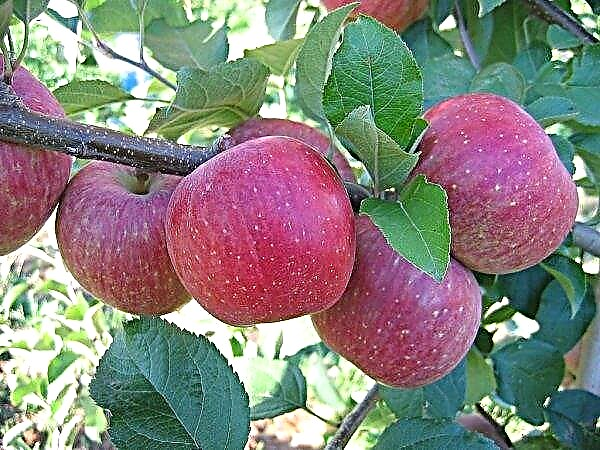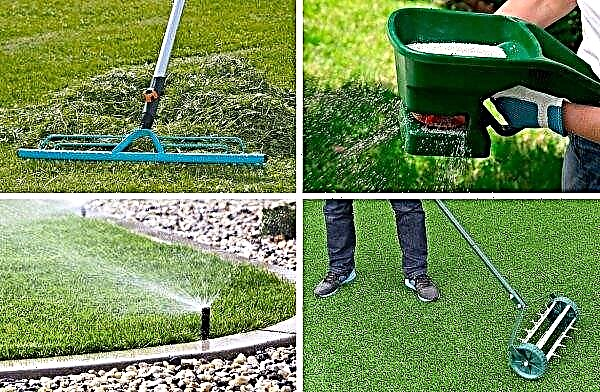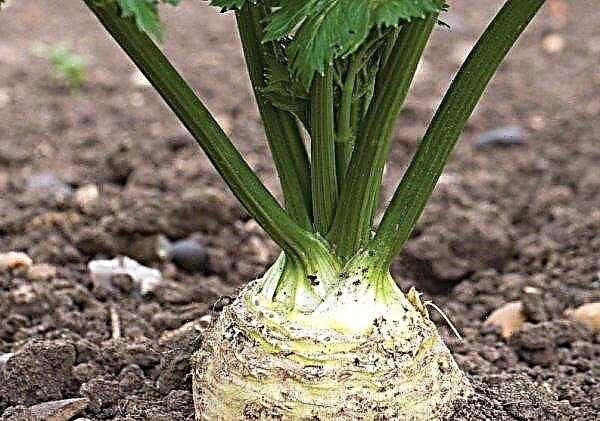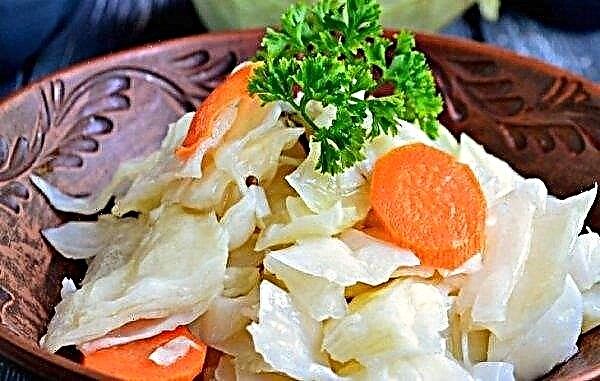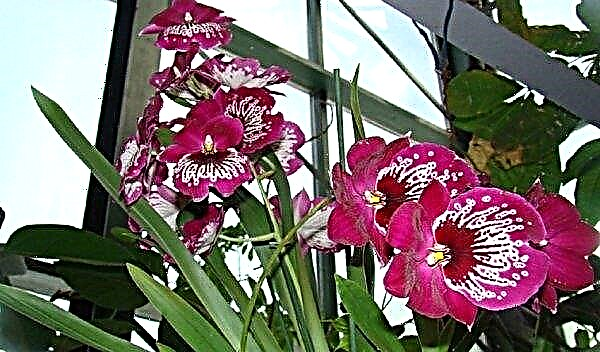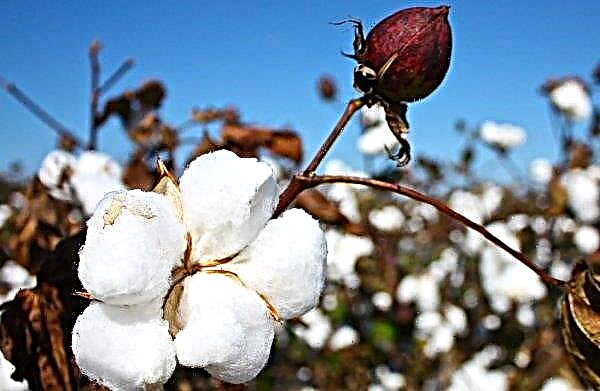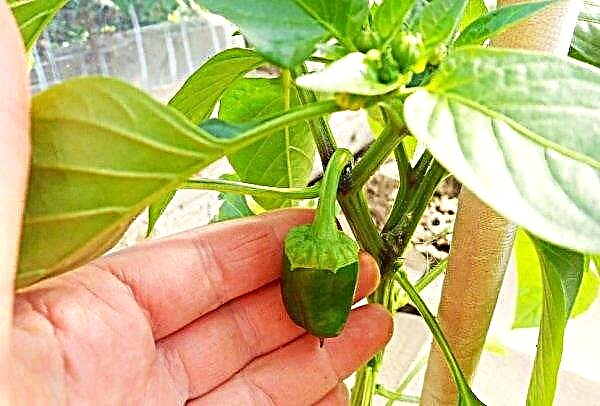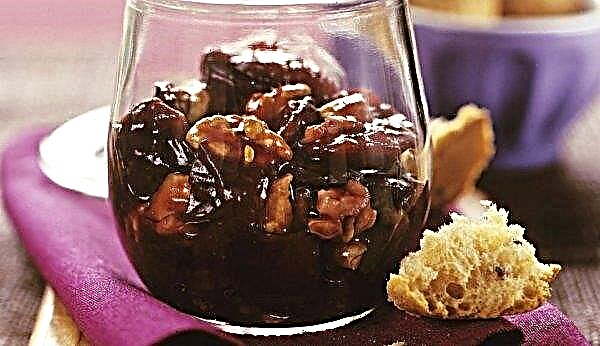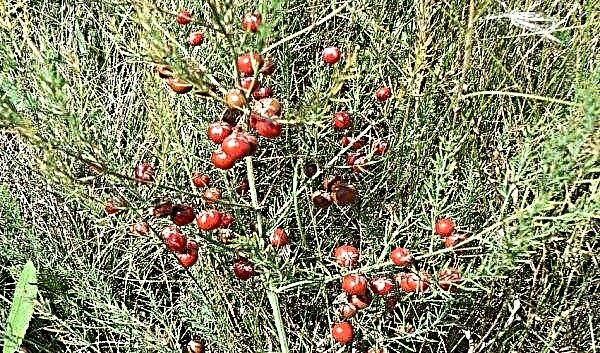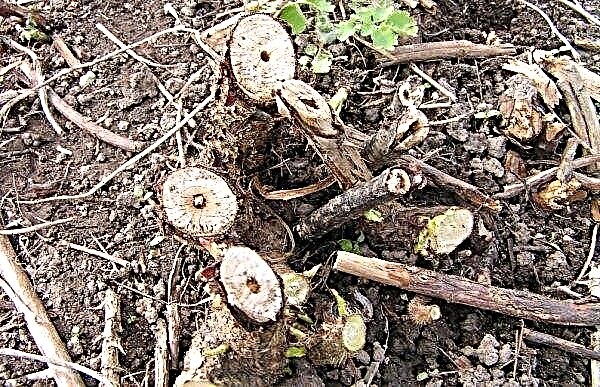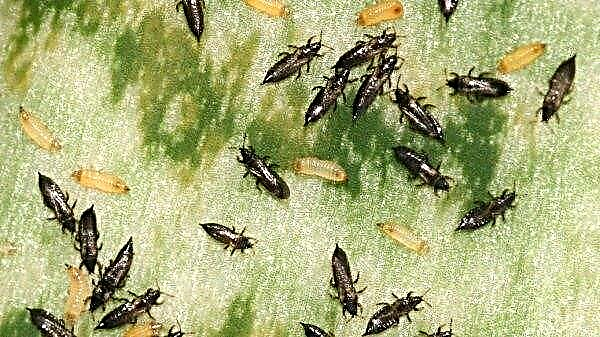Professionals and amateur flower growers try to grow on the windowsill the most striking varieties of tropical flora, which differ in a rather exotic appearance. One of these houseplants is considered to be an aphelander protruding (squarrosa). This bushy plant impresses with its unique shape, as well as unforgettable flowering. This material will discuss the main features of this plant, as well as its basic care requirements.
Botanical description of the plant
The protruding Afelander is considered one of the most prominent representatives of the Acanthus family. This species belongs to the inhabitants of tropical regions, therefore, to this day it can be found in the wild, in the equatorial zone of America. This is an evergreen bushy plant, which reaches a length of up to 2 m, but in indoor conditions it grows no higher than 60 cm. The stem is soft, grassy type, saturated green color.
Did you know? Pot plants first appeared in ancient China, about 5 thousand years ago.
The leaves of the bush are pointed, opposite, smooth and shiny, rather large (about 15 cm long and 5-10 cm wide), collected in a characteristic pineal-shaped rosette. The color of the leaves is variegated, they are covered with a thick, smooth, rich-green skin, on top of which numerous veins of a white hue protrude. A variety of spotty inclusions are also observed on the entire surface of the leaf, giving them a special ornament. The root system of the plant is a fibrous type; it consists of numerous root processes, abundantly covered with many hairs.
This plant blooms from mid-July to October. At this time, elegant spike-shaped inflorescences up to 15 cm long appear on the top of the bush. Bract leaves are most often large, quadrangular, a two-lipped corolla, and orange-yellow. The flowers in inflorescences are saturated yellow, they appear alternately, after which they die off within a few days. Thanks to this, flowering does not stop for several months. After flowering, numerous dark brown, almost black seeds ripen on the bush.House growing conditions
Since afelander refers to tropical species, in order to grow it on the windowsill, you must take care of the necessary microclimate and the regime of maintenance. First of all, attention should be paid to lighting and watering the bush, since these factors often play a decisive role in the growth of the flower, as well as its flowering.
Lighting and ventilation
The flower belongs to the photophilous species, so it must be provided with daylight hours at least 10 hours a day. However, direct sunlight often causes burns on the green mass of the bush, so it is kept in a zone with diffused light or shaded with translucent fabric. From late autumn to late winter, direct sunlight is not scary for afelander, but at the same time, intensive lighting of foliage for more than 4-5 hours should be avoided. They contain a flower on the eastern or western windowsill, but when creating a partial shade, it can also be grown on the southern windows. Such a place must be protected from sudden changes in temperature and drafts. Otherwise, the bush may freeze and slowly fade. However, the flower needs periodic ventilation, because stagnation of air is harmful to it. Conduct it both naturally and artificially, avoiding direct air flows.
They contain a flower on the eastern or western windowsill, but when creating a partial shade, it can also be grown on the southern windows. Such a place must be protected from sudden changes in temperature and drafts. Otherwise, the bush may freeze and slowly fade. However, the flower needs periodic ventilation, because stagnation of air is harmful to it. Conduct it both naturally and artificially, avoiding direct air flows.
Temperature and humidity
The optimum temperature for the development of afelander is considered to be the range +22 ... + 25 ° С, but in winter the bush successfully withstands a decrease in the indicator to +15 ... + 20 ° С. Acanthus belong to rather hygrophilous plants, they like high humidity, so this indicator should be increased to 90%. Particularly strictly for humidity should be monitored in the winter, t. Heating appliances reduce it at times. To moisten the air, use mechanical devices or install a small container of water near the bush.
Home Care
Like any other plant, the afelander needs appropriate care to ensure the safe growth, development and flowering. In this case, in addition to timely watering and top dressing, the bush needs to create artificial suspended animation at low temperatures. Without this, inflorescences will not form on it, which often reduces the overall decorative significance of the flower.
Watering
Afelandra loves moisture, but its overabundance negatively affects the root system and often causes all kinds of putrefactive lesions. Water the flower sparingly, in small portions, reaching about 80% of the total moisture capacity of the substrate when watering. Moisturize the soil at least 1 time in 3 days, but in summer drought, the frequency of the procedure is increased as necessary.
Important! About an hour after watering, it is imperative to drain the water from the pan to avoid the development of fungal infections.
For irrigation use only clean, settled water, previously heated to room temperature, otherwise there is a high probability of catching a flower's roots. Watering is carried out under the root, avoiding the ingress of water on the leaves and stem.
Top dressing
They feed the flower throughout the year. During the active growing season, fertilizers are applied once every 2 weeks, in winter, the multiplicity of the procedure is halved. As a top dressing for afelandra, various universal organic mixtures for flowering plants are used. You can cook them yourself, for this you need to make a solution of humus or cow manure (1:10) or an infusion of chicken manure (1:15).
Pruning
For the first time, pruning of the flower is carried out in the phase of 2-3 leaves, at this time, pinch the top on the plant, which makes it possible to create a more miniature and lush bush. Make pinching as the bush grows, avoiding excessive stretching of the side shoots. As the afelander grows, they also carry out sanitary pruning. They do this in order to remove old, wilted and damaged parts and leaves from the stem. Otherwise, its decorative value, after 1–2 seasons, sharply worsens.
Important! After flowering on an afelander, it is imperative to cut off the inflorescences, otherwise seeds will form on them, after which the bush will slowly die.
The best time for the procedure is the first half of March. It is mandatory to carry out the so-called pruning-rejuvenation, performing it a few years after the cessation of active growth. During the process, the main stem is half removed on the bush, as well as all foliage, with the exception of the first lower tier. This procedure makes it possible to activate sleeping buds and give a mature plant a new life, as well as improve flowering. They begin rejuvenation in early spring, in the first half or mid-March.
Transfer
This flower loves crowding, so a transplant is carried out no more often than every 2–4 years. This is necessary in order to not only increase the volume of the pot, but also to partially replace the substrate with a more fertile one. The best time for the procedure is considered to be mid-March to the end of April, since during this period the procedure with minimal damage will affect the growth of the bush and its immunity. Any garden container made of ceramics, plastic, glass and other materials is suitable for transplanting. Such a vessel should not be toxic, have resistance to aggressive soil compounds, as well as a functional drainage hole.
The new pot should be only a few centimeters larger in diameter than the old one. Loose soil with a high coefficient of air and moisture permeability is used as a substrate for afelander. The most suitable for this is a mixture consisting of equal parts of leafy land, peat and sand. To increase lightness and improve mechanical properties, such soils are diluted to 20% of the total mass with a mixture of charcoal and coconut coir. Transplantation is carried out by the method of transshipment. To conduct it correctly, you should perform the following sequence of actions:
To conduct it correctly, you should perform the following sequence of actions:
- Prepare the container: put drainage of gravel or pebbles about 4 cm thick on its bottom, and then fill it with soil to 1/3.
- Carefully remove the flower from the old bowl and, if possible, remove excess soil. In this case, the basal layer must remain intact.
- Place the plant in a new pot, and then fill it with soil. Strongly compact the soil should not be, otherwise there is a high probability of damage to the roots.
- Water the plant, and after 2 weeks feed it with any solution of organic fertilizers.
Rest period
After flowering, the afelander creates a dormant period. Proper wintering makes it possible to activate the plant’s metabolism in the spring, which best affects the growth of green mass and future flowering.
To organize the resting period correctly, first of all, the bush is transferred to conditions of lowered air temperature in the range +12 ... + 18 ° С. The plant is sharply reduced by top dressing and watering. Under such conditions, with intense diffuse lighting, the bush is maintained throughout the winter, until the beginning of March, after which it is gradually transferred to the standard maintenance mode.
Breeding
The flower propagates both by seeds and by cuttings, including leaf sapling. Regardless of the type of propagation, aphelander is germinated only at high temperature and humidity, as well as a sufficient amount of light. This is one of the main conditions that contribute to the rapid rooting of young flowers.
Cuttings
Propaganda is propagated by cuttings from March to May or from December to January. In spring, the procedure is carried out using stem cuttings, which are lateral shoots about 1 year old and 10-15 cm long (at the top there should be at least 2 leaves). In winter, the largest leaf blades with axillary buds are rooted.
Important! For cuttings only those shoots and leaves are suitable, on top of which inflorescences have not developed.
Cuttings are carried out as follows:
- Cut the cuttings from the plant. Do this with a sharp knife, previously sterilized with 70% alcohol.
- Dip the stalk in a solution of a growth stimulator for 4-6 hours (Zircon, Kornevin, Succinic acid, etc.).
- Fill large garden containers with soil and place cuttings in them. Use for this a mixture based on sand, humus, peat, leafy soil (1: 2: 2: 2).
- Water the container well, and then cover the seedlings with a dome made of transparent polyethylene.
- Transfer the cuttings to a well-lit and warm place (+20 ... + 25 ° C). As the soil dries up, the stalk needs to be moistened well with a spray gun. After 4-6 weeks, the seedling is completely rooted, after which you can remove the cover and transplant the plant into a separate pot.

Seeds
Reproduction using seeds is a more painstaking way to get a young bush, but it is indispensable if you want to grow a new hybrid variety on the windowsill.
Sow the seeds from mid-February to mid-March as follows:
- Fill tightly wide containers with a substrate of sand and sheet earth (4: 1).
- Sterilize the seeds (for this, they are soaked for 20-30 minutes in a 2% solution of potassium permanganate or for 5-10 minutes in 70% alcohol).
- Make longitudinal grooves or pits with a row spacing of 5 cm on the soil, place the seeds in them, wrap the soil, and then water well.
- Cover the flowerpot with polyethylene or glass and put in a warm (+20 ... + 25 ° С) illuminated place.
- After a few weeks, the seeds will germinate, after which in the phase of 2-3 leaves the seedlings dive into a separate container.

Possible growing difficulties
Since the protruding afelander is a traditional inhabitant of equatorial latitudes, problems with it occur quite often when grown in a pot. Usually, errors in care lead to this, which creates a favorable environment for reducing immunity and the development of various pathologies.
Disease
The main diseases that affect the protruding Afelander, as well as the painful conditions and their causes, are presented in the table below:
| Description | Cause |
| Withering or drying of leaf tips | Excessively dry air in a room with a humidity of less than 65% |
| Bush lowered foliage | Deficiency or stagnation of moisture in the substrate |
| Leaf fall | Dry or waterlogged air, lack of lighting |
| Dark spots on foliage and shoots | Damage to the root system with bacterial rot |
| Varied sheet plate deformations | Violation of the lighting mode or excessively high temperature |
| Rot at the base of the trunk and leaves | Excess moisture in the soil |
| Stretching the stem | Lack of lighting |
| The stem is covered with putrefactive inclusions (late blight) | The bush is affected by a pathogenic fungus. |
| Root rot | Violation of the growing regime, which leads to fungal infections |
It happens that the bush does not bloom. Most often this provokes:
Most often this provokes:
- a very large pot and other violations of the transplant technique;
- lack of peace;
- damage to the bush by diseases or pests;
- lack of nutrients in the substrate;
- insufficiently intense lighting.
Did you know? The modern houseplant culture began in the 16th century, during the colonial conquests. At this time, various exotic species were massively imported into Europe, on the basis of which the first greenhouses and all kinds of decorative varieties appeared.
Pests
The most common bush pests:
| Title | Symptoms of lesion |
| Mealybug | The leaves fade and curl, the growth of the bush is greatly inhibited |
| Aphid | Small green or brown insects appear on the underside of the leaves. They feed on leaf juice, causing them to wilt. |
| Nematodes | Shrub growth instantly slows down, green mass slowly fades, roots fade and die |
Afelandra protruding is a whimsical plant that needs daily attention. Only an experienced grower can grow such a homely flower. However, with the necessary care, the plant will thank with abundant flowering and continued growth over many years.

